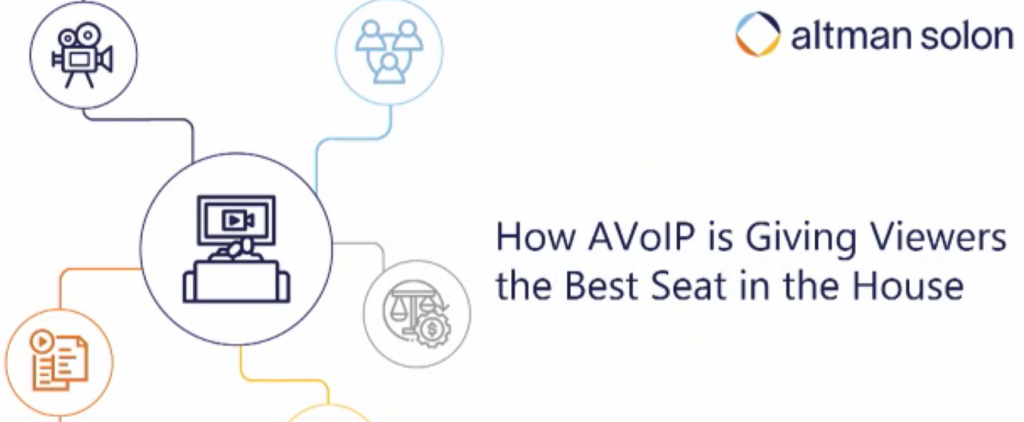M+E Daily

HITS 2023: Altman Solon Explores How AVoIP Gives Viewers the Best Seat in the House
Story Highlights
A growing number of broadcasters are turning to Audio and Video over Internet Protocol (AVoIP) to meet growing consumer demand for seamless live streaming, according to Derek Powell, director at consulting firm Altman Solon.
Live televised events have produced some of the most memorable moments in TV history.
From sporting spectacles including the Olympics to the coronation of King Charles III, live events tend to draw huge TV ratings and create lucrative advertising partnerships.
But that is only if broadcasters can deliver the content viewers want to watch while navigating economic and logistical challenges, Powell said May 23 at the Hollywood Innovation and Transformation Summit (HITS) at The Culver Theater, during the breakout session “How AVoIP Is Giving Viewers the Best Seat in the House.”
In today’s world of rapid technological evolution, broadcasters’ inability to adapt to the changing environment equates to profit left on the table.
One big question is: How can broadcasters take a long term, strategic view toward investments, talent and operational structures to reap the full value of AVoIP? J
During the session, Powell explored trends and insights from his firm’s recent AVoIP white paper.
 His firm saw it as an “important topic because, not only were streaming platforms struggling in terms of managing their respective business on the description model, but there tended to be additional interest in and around live streaming and how that would impact various components of the media industry, particularly as it relates to ecosystem and the changes that need to happen across that,” he told attendees.
His firm saw it as an “important topic because, not only were streaming platforms struggling in terms of managing their respective business on the description model, but there tended to be additional interest in and around live streaming and how that would impact various components of the media industry, particularly as it relates to ecosystem and the changes that need to happen across that,” he told attendees.
The researchers also tried to “understand some of the adoption aspects related to some of the vendors, different parts of the ecosystem in terms of what was important to them and how they needed to be able to adjust to ensure that they’re successful in supporting this,” he noted.
He told attendees: “What’s nice about this is that we’ve actually heard in recent weeks of streaming platforms now trying to support live streaming around their respective platforms. So it’s a timely conversation but it’s something that we’re going to continue managing and monitoring as we move forward.”
Three key aspects that he wanted attendees to take away from the white paper were: “AVoIP continues to expand and its adoption continues to be readily accepted by a wide number of media tech companies and content producers and distributors. Talent is an issue.”
He noted that, during a session earlier in the day, he mentioned “some aspects around understanding the gaps between what’s happening today with regards to how content is managed and distributed today versus how it needs to be moving forward, and the skills gap around how you migrate from the current state application today to tomorrow’s IP-based sort of infrastructure and architecture is still a widening gap.”
The last significant aspect is data collection, he said, explaining: “This is one of the areas where I think there is some untapped opportunity for a lot of the respective media tech companies and content producers to be able to look at when it comes to understanding how is that signal processed, and then how is it reaching the various consumers. And then what do you do with that signal in terms of some of the rich information you’re able to retrieve from it.”
In terms of the demand for live, “high quality content,” including sports and news, “one of the things that we wanted to do as part of our study was to understand what were some of the dynamics or some of the consumer trends that we should be capturing as we consider some of the changes that need to happen across our ecosystem,” he said.
Therefore, he explained: “The first thing we looked at was looking at just in terms of the overall infrastructure spend around what’s happening in that space.” The researchers “tried to look at some of the increased standards around what consumers wanted to look and feel in terms of how they’re consuming that live content and what was really important to them,” he said. “And one of the things here is viewer engagement.”
The last piece, he added, was what’s going to incentivize broadcasters in this case to be able to, and I use that term very loosely, is basically anyone who’s acquiring the signal to be able to capture a particular event and then distribute that out,” he pointed out. “But what kind of incentives are in place to be able to get them to produce more live events?”
He said: “If I am a particular broadcaster and I have a respective set of programming that’s involved, I can be able to generate my playlist and even include ads in that, and then let that play out.”
 However, he added: “When it comes to live events, you almost have to work on the fly. And so this requires a lot more infrastructure in terms of being able to handle a lot of the variations that may or may not happen during that respective live feed. We also look at some of the aspects in this case here … where we felt consumers are looking at having more content to consume,” including sports.
However, he added: “When it comes to live events, you almost have to work on the fly. And so this requires a lot more infrastructure in terms of being able to handle a lot of the variations that may or may not happen during that respective live feed. We also look at some of the aspects in this case here … where we felt consumers are looking at having more content to consume,” including sports.
There has been a “steady increase in adoption or at least consumption of what consumers want to be able to watch live,” he said, explaining: “We also are tracking some of these sports rights in terms of how they’re managed as well because that’s really important in terms of being able to understand what kind of rights are being granted. And, of course, when we think about sports rights, they’re typically granted over a longer period of time. But then once you tap out the first, the top-tier professional sports or teams, you start to get into tier two and tier three, which, in some cases, can be more lucrative from a broadcasting perspective because sports rights then are not as expensive and you can also be able to monetize that with niche audiences.”
The researchers also looked at “some of the aspects related to what’s really sort of driving the increase in demand related to” the AVoIP infrastructure and the top reason was focused around customer requirements,” he noted. “The customer, in this case, the content producer or whoever is actually managing that live event, is actually requesting more and more of these requirements to be not only low latency but also high quality when it gets to the actual targeted audience.”
The Hollywood Innovation and Transformation Summit event was produced by MESA in association with the Hollywood IT Society (HITS) and presented by Amazon Studios Technology, with sponsorship by Fortinet, Genpact, Prime Focus Technologies, Signiant, Softtek, Convergent, Gracenote, Altman Solon, AppTek, Ascendion, CoreSite, EPAM, MicroStrategy, Veritone, CDSA, EIDR and PDG Consulting.









